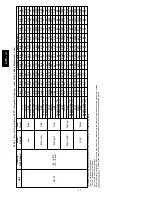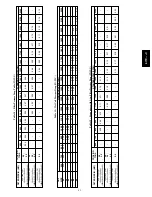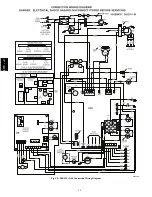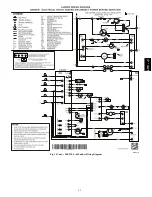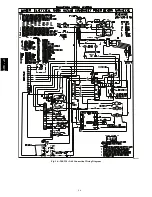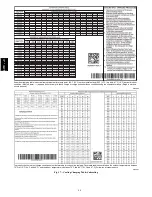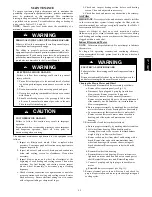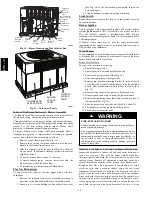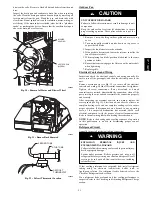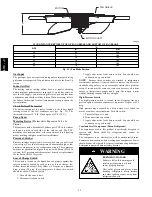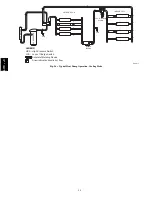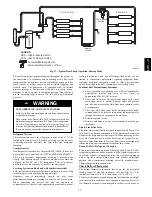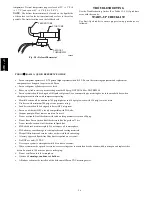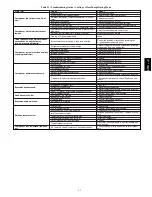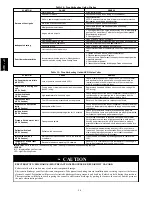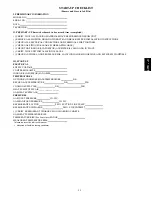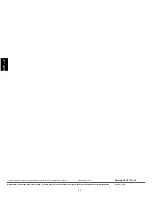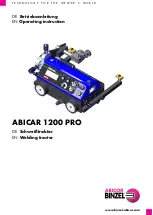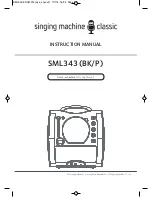
55
COMPRESSOR
ACCUMULATOR
OUTDOOR COIL
INDOOR COIL
LCS
LEGEND
HPS – High Pressure Switch
LCS – Loss of Charge Switch
Accurater
®
Metering De vice
Arrow indicates direction of flo
w
Position
HP S
TXV in Bypass
Metering
Position
C03012
Fig. 27 -- Typical Heat Pump Operation, Heating Mode
The scroll compressor pumps refrigerant throughout the system by
the interaction of a stationary and an orbiting scroll. The scroll
compressor has no dynamic suction or discharge valves, and it is
more tolerant of stresses caused by debris, liquid slugging, and
flooded starts. The compressor is equipped with an internal
pressure relief port. The pressure relief port is a safety device,
designed to protect against extreme high pressure. The relief port
has an operating range between 550 and 625 psig differential
pressure.
UNIT OPERATION AND SAFETY HAZARD
Failure to follow this warning could result in personal injury
or equipment damage.
This system uses Puron (R--410A) refrigerant which has
higher operating pressures than R--22 and other refrigerants.
No other refrigerant may be used in this system. Gauge set,
hoses, and recovery system must be designed to handle Puron.
If you are unsure, consult the equipment manufacturer.
WARNING
!
Refrigerant System
This information covers the refrigerant system of the 677C----B
including the compressor oil needed, servicing systems on roofs
containing synthetic materials, the filter drier and refrigerant
charging.
Compressor Oil
If additional oil is needed use Uniqema RL32--3MAF. If this oil is
not available, use Copeland Ultra 32CC or Mobil Artic EAL22CC.
This oil is extremely hygroscopic, meaning it absorbs water
readily. POE oils can absorb 15 times as much water as other oils
designed for HCFC and CFC refrigerants. Take all necessary
precautions to avoid exposure of the oil to the atmosphere.
Servicing Systems on Roofs and with Synthetic materials
POE (polyolester) compressor lubricants are known to cause long
term damage to some synthetic roofing materials.
Exposure, even if immediately cleaned up, may cause
embrittlement (leading to cracking) to occur in one year or more.
When performing any service that may risk exposure of
compressor oil to the roof, take appropriate precautions to protect
roofing. Procedures which risk oil leakage include, but are not
limited to, compressor replacement, repairing refrigerant leaks,
replacing refrigerant components such as filter drier, pressure
switch, metering device, coil, accumulator, or reversing valve.
Synthetic Roof Precautionary Procedure
1. Cover extended roof working area with an impermeable
polyethylene (plastic) drip cloth or tarp. Cover an
approximate 10x10 ft (3x3 m) area.
2. Cover area in front of the unit service panel with a terry
cloth shop towel to absorb lubricant spills and prevent
run--offs, and protect drop cloth from tears caused by tools
or components.
3. Place terry cloth shop towel inside unit immediately under
component(s) to be serviced and prevent lubricant run--offs
through the louvered openings in the unit base.
4. Perform required service.
5. Remove and dispose of any oil contaminated material per
local codes.
Liquid Line Filter Drier
This filter drier is specifically designed to operate with Puron. Use
only factory--authorized components. Filter drier must be replaced
whenever the refrigerant system is opened. When removing a filter
drier, use a tubing cutter to cut the drier from the system. Do not
unsweat a filter drier from the system. Heat from unsweating will
release moisture and contaminants from drier into system.
Puron (R--410A) Refrigerant Charging
Refer to unit information plate and charging chart. Some R--410A
refrigerant cylinders contain a dip tube to allow liquid refrigerant to
flow from cylinder in upright position. For cylinders equipped
with a dip tube, charge Puron units with cylinder in upright
position and a commercial metering device in manifold hose.
Charge refrigerant into suction--line.
Check Defrost Thermostat
The defrost thermostat is usually located on the lowest liquid
leaving circuit of the left condenser coil (see Fig. 28). The
thermostat closes at 32
_
F (0
_
C) and opens at 65
_
F (18
_
C).
The defrost thermostat signals heat pump that conditions are right
for defrost or that conditions have changed to terminate defrost. It
is a thermally actuated switch clamped to outdoor coil to sense its
677C
--
--
C
Содержание Legacy 677C**C Series
Страница 3: ...3 A150538 Fig 2 24 30 Unit Dimensions 677C C...
Страница 4: ...4 A150539 Fig 3 36 60 Unit Dimensions 677C C...
Страница 44: ...44 A150506 Fig 15 208 230 1 60 Connection Wiring Diagram 677C C...
Страница 45: ...45 A150516 Fig 15 Cont 208 230 1 60 Ladder Wiring Diagram 677C C...
Страница 46: ...46 A150507 Fig 16 208 230 3 60 Connection Wiring Diagram 677C C...
Страница 47: ...47 A150517 Fig 16 Cont 208 230 3 60 Ladder Wiring Diagram 677C C...


